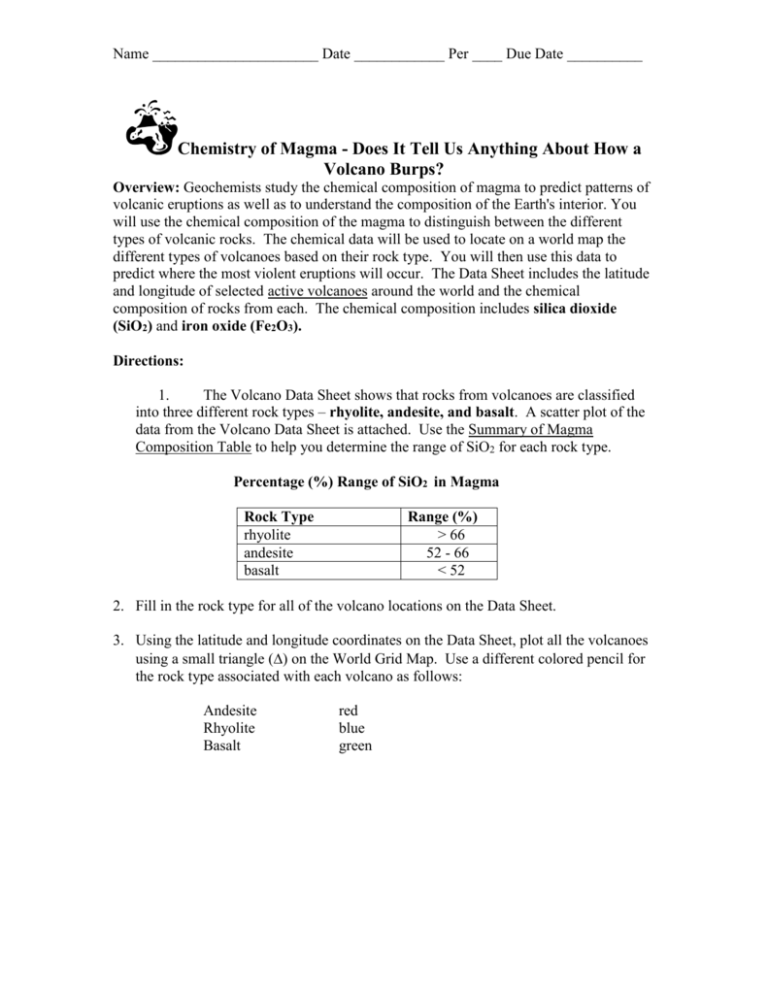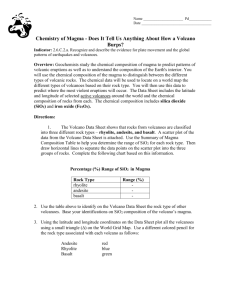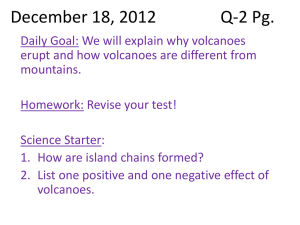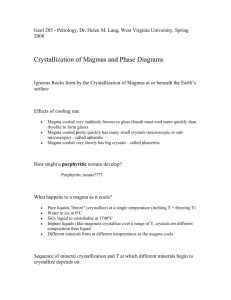File
advertisement

Name ______________________ Date ____________ Per ____ Due Date __________ Chemistry of Magma - Does It Tell Us Anything About How a Volcano Burps? Overview: Geochemists study the chemical composition of magma to predict patterns of volcanic eruptions as well as to understand the composition of the Earth's interior. You will use the chemical composition of the magma to distinguish between the different types of volcanic rocks. The chemical data will be used to locate on a world map the different types of volcanoes based on their rock type. You will then use this data to predict where the most violent eruptions will occur. The Data Sheet includes the latitude and longitude of selected active volcanoes around the world and the chemical composition of rocks from each. The chemical composition includes silica dioxide (SiO2) and iron oxide (Fe2O3). Directions: 1. The Volcano Data Sheet shows that rocks from volcanoes are classified into three different rock types – rhyolite, andesite, and basalt. A scatter plot of the data from the Volcano Data Sheet is attached. Use the Summary of Magma Composition Table to help you determine the range of SiO2 for each rock type. Percentage (%) Range of SiO2 in Magma Rock Type rhyolite andesite basalt Range (%) > 66 52 - 66 < 52 2. Fill in the rock type for all of the volcano locations on the Data Sheet. 3. Using the latitude and longitude coordinates on the Data Sheet, plot all the volcanoes using a small triangle () on the World Grid Map. Use a different colored pencil for the rock type associated with each volcano as follows: Andesite Rhyolite Basalt red blue green Name ______________________ Date ____________ Per ____ Due Date __________ Follow-up Questions: 1. Look at the Plate Tectonics Map on page 83 in the textbook. Describe the general relationship between the location and type of volcanoes plotted and the type of tectonic plate boundary (convergent, divergent or transform). _____________________________________________________________________ _____________________________________________________________________ _____________________________________________________________________ 2. What happens to the percentage of silicon dioxide (SiO2) as the percentage of iron oxide (Fe2O3) in volcanic rocks increases? Refer to the Data Sheet to determine the correlation. _____________________________________________________________________ _____________________________________________________________________ 3. Silicon dioxide (SiO2) in magma is one factor that controls the violence of volcanic eruptions. Magma from the most violent eruptions has a higher percentage of silica compared to quiet eruptions. Use the Summary of Magma Composition Table to complete the chart below. Label the type of eruption as either violent, quiet to violent or quiet based on percent of SiO2. Type of Rock Relative % of SiO2 Most Intermediate Least Type of Eruption 4. Which rock is most associated with a violent eruption? ________________________________________________________________________ ________________________________________________________________________ Name ______________________ Date ____________ Per ____ Due Date __________ DATA SHEET Volcano Location Pacific U.S. 1. Lassen, CA 2. Crater Lake, OR 3. Mt. Rainier, WA 4. Mt. Baker, WA U.S. Interior 5. Yellowstone Park, WY 6. Craters of the Moon, ID 7. San Francisco Peaks, AZ Central America/West Indies 8. Paricutin, Mexico 9. Popocatepetl, Mexico 10. Mt. Pelee, Martinique 11. Santa Maria, Guatemala 12. Mt. Misery, St. Kitts South America 13. Cotopaxi, Ecuador 14. Misti, Peru Alaska and Aleutian Islands 15. Katami, Alaska 16. Adak, Aleutians 17. Umnak Island, Aleutians 18. Kamchatka, Russia Japan 19. Mt. Fuji, Honshu 20. Izu-Hakone, Honshu East Indies 21. Mayon, Philippines 22. Krakatoa, Java & Sumatra 23. Karkar, New Guinea Central Pacific 24. Mauna Loa, Hawaii 25. Galapagos Islands 26. Mariana Islands South Pacific 27. Aukland, New Zealand 28. Tahiti 29. Samoa North Atlantic 30. Surtsey, Iceland 31. Mid-Ocean Ridge Africa 32. Kilimanjaro, Tanzania Latitude Longitude % of Magma Composition SiO2 Al2O3 FeO + Fe2O3 40N 43N 47N 49N 121W 122W 122W 122W 57.3 55.1 62.2 57.4 18.3 18.0 17.1 16.6 6.2 7.1 5.1 8.1 45N 43N 35N 111W 114W 112W 75.5 53.5 61.2 13.3 14.0 17.0 1.9 15.2 5.7 19N 19N 15N 15N 17N 102W 98W 61W 92W 63W 55.1 62.5 65.0 59.4 59.8 19.0 16.6 17.8 19.9 18.3 7.3 4.9 4.5 5.9 7.3 1S 16S 78W 71W 56.2 60.1 15.3 19.0 9.7 5.0 58N 52N 53N 57N 155W 177W 169W 160E 76.9 60.0 52.5 60.6 12.2 17.0 15.1 16.4 1.4 6.9 12.8 7.9 35N 35N 139E 139E 49.8 53.8 20.6 14.8 11.2 13.0 13N 6S 5S 124E 105E 176E 53.1 67.3 60.1 20.0 15.6 16.4 8.2 4.3 9.6 19N 1S 16N 156W 91W 145E 49.6 48.4 51.2 13.2 15.4 17.3 11.9 11.8 10.9 38S 18S 13S 176E 149W 172W 49.3 44.3 48.4 15.6 14.3 13.3 11.9 12.4 12.3 63N 60N 20W 30W 50.8 48.2 13.6 16.5 12.5 11.7 3S 37E 45.6 10.3 12.6 Rock Type Name ______________________ Date ____________ Per ____ Due Date __________








